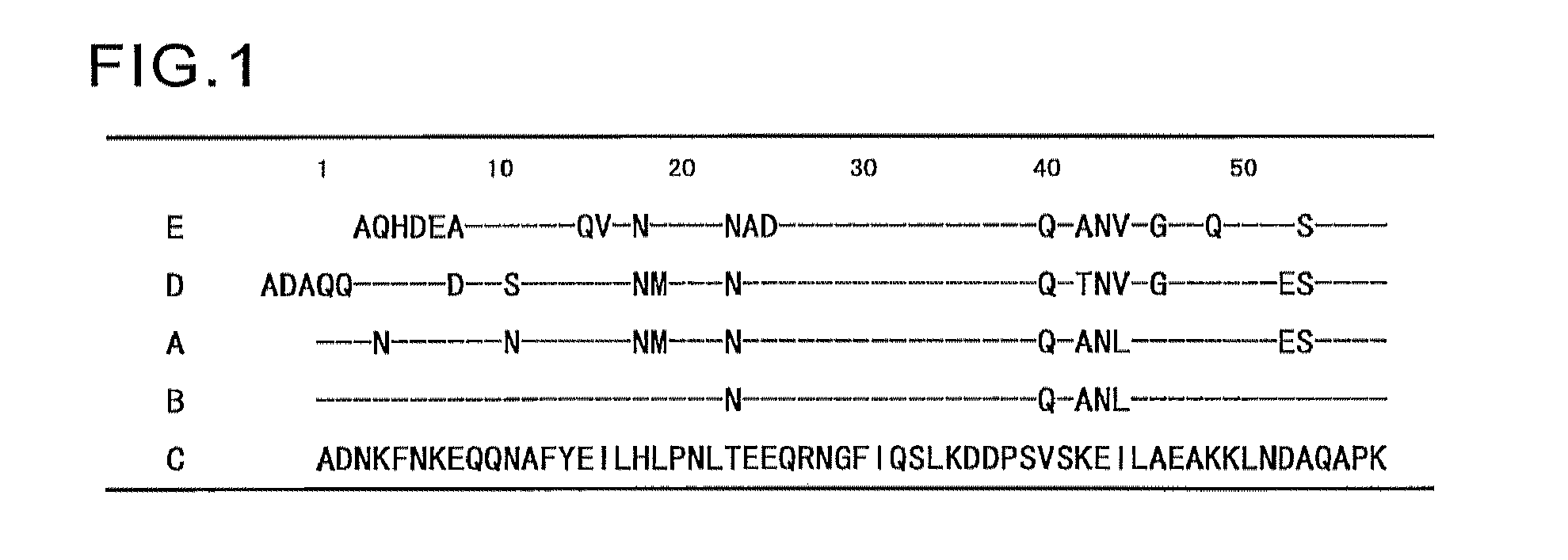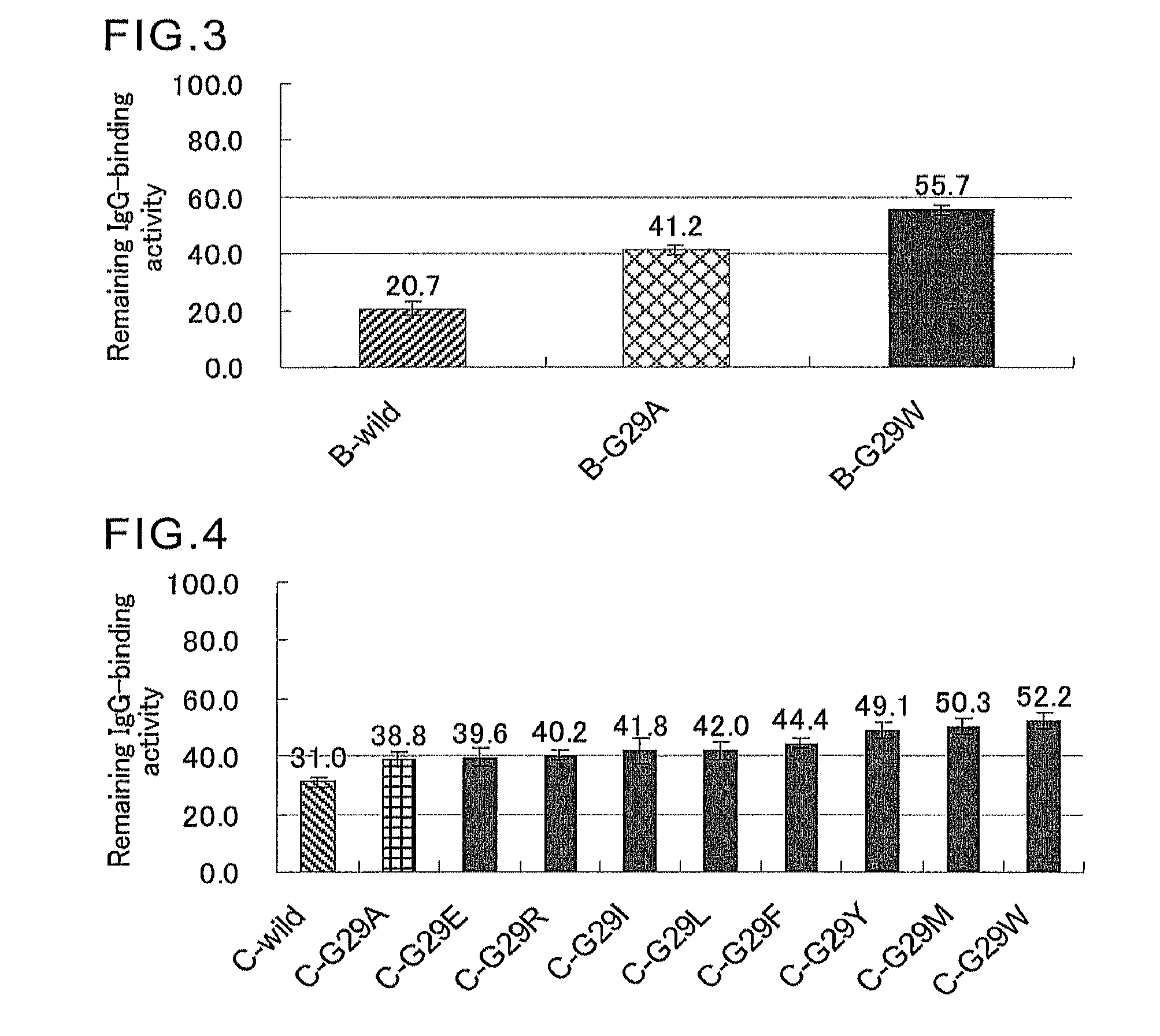Protein having affinity for immunoglobulin, and immunoglobulin-binding affinity ligand
a technology of immunoglobulin and affinity ligand, which is applied in the direction of immunoglobulins against bacteria, peptides, dna/rna fragmentation, etc., can solve the problems of insufficient ability, difficulty in dissociating an antibody binding to the c domain using acid, and insufficient ability of the c domain mutant to dissociate antibodies, etc., to achieve satisfactory antibody dissociation properties, high sequence identity, and high alkali resistance
- Summary
- Abstract
- Description
- Claims
- Application Information
AI Technical Summary
Benefits of technology
Problems solved by technology
Method used
Image
Examples
example 1
Preparation of DNA Encoding Wild-Type C Domain (C-Wild)
[0129]A DNA fragment (177 bp) encoding C-wild (SEQ ID NO:5) was amplified by PCR using the oligonucleotide primers of SEQ ID NOs:19 and 20 and the expression vector pNK3262NX encoding wild-type Protein A as a template. The vector pNK3262NX used as a template is a known Protein A expression vector produced by altering a part of the vector pNK3260, and encodes wild-type Protein A except a part of the cell wall-anchoring domain X and the like (WO 06 / 004067). The base sequence encoding the C-wild produced in the present example is shown as SEQ ID NO:21. The oligonucleotide primers of SEQ ID NOs:19 and 20 were constructed such that DNAs amplified using these primers had restriction enzyme recognition sites BamHI and EcoRI on the opposite sides of the gene encoding the C-wild and that the C-wild had a Cys residue on the C-terminal side (downstream of Lys-58)
[0130]The obtained DNA fragment was digested with the restriction enzymes BamH...
example 2
Preparation of DNA Encoding Wild-Type B Domain (B-Wild)
[0132]As shown in FIG. 1, the amino acid sequence of B-wild (SEQ ID NO:4) can be obtained by introducing the mutations T23N, V40Q, K42A, E43N and 144L into the C-wild. Therefore, a DNA encoding the B-wild was prepared by introducing the mutations T23N, V40Q, K42A, E43N and 144L into the DNA (SEQ ID NO:21) encoding the C-wild. A plasmid containing a gene encoding an amino acid sequence in which the mutation of T23N was introduced into the C-wild was obtained by quick change mutagenesis using the oligonucleotide primers of SEQ ID NOs:22 and 23 and the C-wild expression plasmid produced in Example 1 as a template. Then, a GST fused B-wild expression plasmid containing a gene encoding the B-wild was produced by introducing the mutations V40Q, K42A, E43N and 144L by quick change mutagenesis in the same manner as described above, using the oligonucleotide primers of SEQ ID NOs:24 and 25 and the produced plasmid as a template.
[0133]Esc...
example 3
Introduction of Mutation at Gly-29
[0135]Genes encoding mutants were prepared by quick change mutagenesis using primers of SEQ ID NOs:27 to 52 shown in Table 1, and the C-wild expression plasmid produced in Example 1 and the B-wild expression plasmid produced in Example 2 as templates.
[0136]Expression plasmids encoding the C-domain mutants (C-G29Xs) of SEQ ID NOs:6 to 18 in which the Gly-29 in the amino acid sequence of SEQ ID NO:5 was replaced with Val, Leu, Ile, Tyr, Phe, Thr, Trp, Ser, Asp, Glu, Arg, His, or Met, were produced using the C-wild expression plasmid as a template. Likewise, expression plasmids encoding the B-domain mutants (B-G29Xs) of SEQ ID NOs:53 to 56 in which the Gly-29 in the amino acid sequence of SEQ ID NO:4 was replaced with Val, Arg, Asp, or Trp, were produced using the B-wild expression plasmid as a template.
[0137]Escherichia coli HB 101 cells were transformed using the expression plasmids containing genes encoding SEQ ID NOs:6 to 18 and 53 to 56 produced b...
PUM
| Property | Measurement | Unit |
|---|---|---|
| temperature | aaaaa | aaaaa |
| temperature | aaaaa | aaaaa |
| temperature | aaaaa | aaaaa |
Abstract
Description
Claims
Application Information
 Login to View More
Login to View More - R&D
- Intellectual Property
- Life Sciences
- Materials
- Tech Scout
- Unparalleled Data Quality
- Higher Quality Content
- 60% Fewer Hallucinations
Browse by: Latest US Patents, China's latest patents, Technical Efficacy Thesaurus, Application Domain, Technology Topic, Popular Technical Reports.
© 2025 PatSnap. All rights reserved.Legal|Privacy policy|Modern Slavery Act Transparency Statement|Sitemap|About US| Contact US: help@patsnap.com



